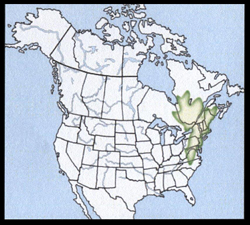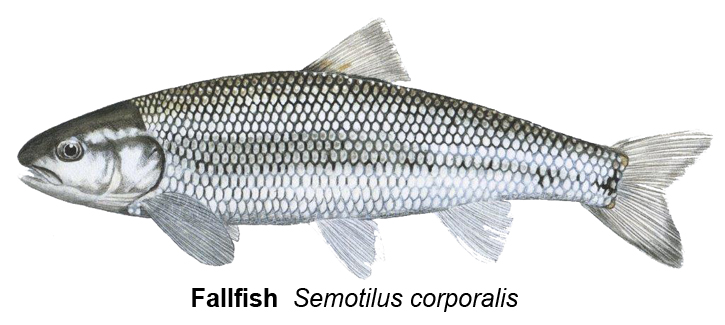Fallfish, November 2013, Fish of the Month!
A Brief Note to Our Readers:
Arranged in taxonomic (scientific) order, this column has, with this entry, passed out of the realm of our fly rod glamour species, the Trouts and Salmons (and even the Pikes), and into a broader realm of generally warm water-loving species. To this end, we’ll jump into these habitats and species with both feet and begin with the Minnows.
“Minnows?!?” we can hear you exclaiming. Yes, minnows. “You mean there are 30 pound minnows?!?” Yup, there are and we’re going to lead into all this with two of them.
Fallfish
Semotilus corporalis
Local Names:
Chub, Dace, Shining dace, Chivin, Windfish, Silver chub, American chub, Mohawk, Corporal, Whiting
Average Size:
6 to 12 inches
0.50 to 0.75 pound
Distinguishing Field Marks:
(See the illustration.)
-
Fallfish tend to be very silvery on their sides with white bellies and gray, brown, or olive backs.
-
This typical color pattern changes to dark reds and olives during spawning and occasionally to better blend into darker habitats.
-
The head has a blunt profile.

The mouth is small with its upper jaw ending below the leading edge of the eye.
-
There is no adipose fin.
-
The tail fin is moderately forked.
There are no markings on the fins.
North American Range:
Map to the right shows approximate range in North America.
Diet:
Both young and adult Fallfish feed on both immature and adult aquatic insects, other invertebrates, and some fish.
Biology:
Fallfish spawn in spring, usually in May in small streams and tributaries of larger waters. In preparation for spawning, mature males carry stones upstream to build a nest mound. These mounds can be quite large, especially when one considers the average size of the builders, the largest males may make nest mounds some 5 to 6 feet in diameter and 3 feet high. A male and female simultaneously release eggs and milt up stream from the nest mound and the fertilized eggs fall into the crevices where they incubate for a period of about a week, then remain in the nest until the yolk sac is consumed and they swim free and begin feeding.
This should answer your questions concerning the nature of and reason for those conical stone mounds probably every trout angler has seen in his or her in-stream wanderings.
Fly Fishing for Fallfish:
It is more likely that Fallfish will locate the angler rather than the latter’s actively seeking the former. Fallfish are found in their eastern North American range in those clear streams, rivers, and ponds where trout, salmon, and Smallmouth bass are found. They are willing takers of all forms of the artificial fly and may sometimes be found in large concentrations. They are not strong fighters when hooked, and are seldom eaten, although the flesh is reported be of good quality.
We’ve included the Fallfish here because it is a common eastern minnow that can grow to 18 inches (45.75 cm.) and will almost inevitably be caught at some time by nearly every northeastern trout or Smallmouth bass angler. Anyone interested in teaching youngsters how to fly-fish will find the Fallfish a very willing target on which to refine their skills.
Should you decide to use Fallfish as teaching devices, your favorite light trout outfits and flies will work very well, and, as mentioned above, typically share habitats with trout and bass, so your young fly-fishing students may find themselves attached to one or more of those more glamorous species as an added incentive to their keeping a fly in the water.
Significance to Humans:
Minimal, but the fallfish forms at least part of the forage base for more traditionally desirable food and game fish.
Status:
Self maintaining very well and in usually large numbers through natural reproduction.







